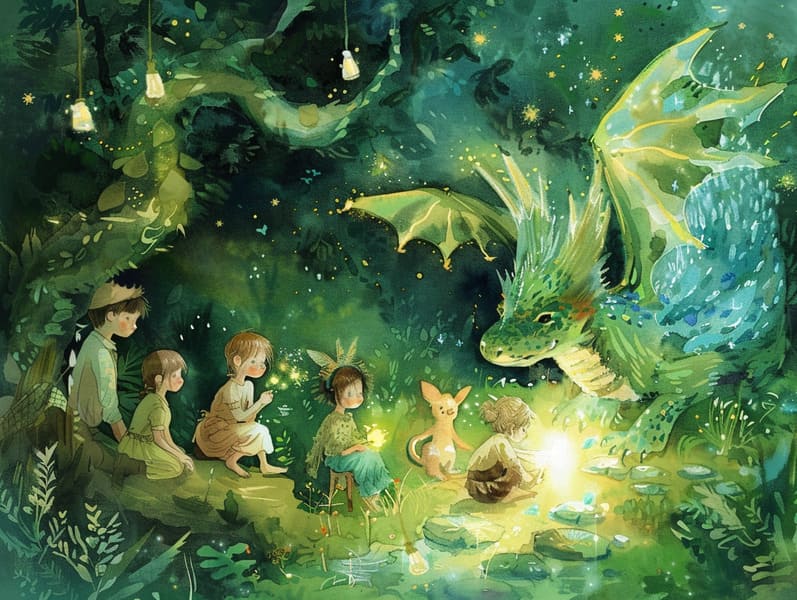Embracing the Magic of Nighttime Narratives: Creating Valued Occasions with Your Family
Embracing the Magic of Nighttime Narratives: Creating Valued Occasions with Your Family
Blog Article

Bedtime is a cherished time for caregivers and children. It’s a moment to relax, snuggle, and delight in the charm of nightly stories.
For ages, children's bedtime stories have been a valued custom, offering more than just a way to go to sleep. They provide an moment for affection, discovery, and fueling vision.
Why Bedtime Stories Matter
Sleep stories for kids do more than a way to end the day. They play a key role in a child’s maturation and in strengthening the parent-kid relationship. Here’s why they matter:
1. Together Time: Reading together at bedtime fosters a special time of affection between kids and their parents. It’s a moment of proximity that helps children feel secure and content.
2. Language Skills: Enjoying narratives helps children develop their communication skills. They learn new expressions, understand sentence structures, and develop their understanding and grasping abilities.
3. Creative Thinking: Bedtime tales lead them to imaginary worlds, nurturing inventiveness. They visualize characters, settings, and adventures, which powers their innovation.
4. Emotional Understanding: Bedtime narratives often feature characters facing obstacles and emotions. These plots help kids interpret and manage their own states, fostering emotional intelligence.
5. Cognitive Development: Being read a tale helps children develop concentration, recollection, and logical thinking. They improve to follow stories, remember facts, and project conclusions.
Making Bedtime Stories a Nightly Habit
Starting a bedtime custom that involves reading narratives is easy and worthwhile. Here’s how to make it a valued part of your night-time tradition:
1. Pick a Cozy Area: Identify a snug place where you and your child can huddle together without noise. A peaceful bed or a relaxing reading nook works great.
2. Set a Consistent Time: Fix a regular time each night for reading. Regularity helps children anticipate and makes the routine easier to maintain.
3. Choose Age-Fitting Stories: Choose tales that are tailored to your child’s developmental stage. Little kids might prefer easy books with straightforward tales, while school-age kids may appreciate chapter books with more complex plots.
4. Animate the Tale: Make sure the tale be engaging by trying different tones and voices, adding story sounds, and getting your child to join in. Ask queries about the story to involve them.
5. Make a Calm Setting: Softly light the lights, use calm voices, and create a calming environment to help your child relax.
Where to Find Great Bedtime Stories
There are countless places where you can find great bedtime stories for children. Here are some choices to look at:
1. Children’s Books: Try your local library or bookstore to find a great selection of bedtime stories for kids. Looking through the choices together can be a great activity that also gives children to decide on stories that capture their interest.
2. Internet Sources: There are many online platforms that offer free bedtime stories. Sites like free story websites provide a variety of short stories for kids that you can read on screen. These choices are great for finding new and assorted stories without expense.
3. Apps for Storytelling: For nights when you’re too exhausted to read, try audiobooks or storytelling apps. These can provide a relaxing voice to read your child a story, ensuring they still get their bedtime story fix. Apps often offer interactive parts that can involve them further.
4. Tailored Stories: Make your own stories inspired by your child’s preferences. Personalized stories can be remarkably engaging and meaningful. You can incorporate your child in the narration process, making them a part of the adventure.
Short Story Benefits
Concise stories for kids are very effective for bedtime. They provide all the good aspects of longer stories but are more to the point, making them perfect for getting ready for bed before sleep. Here’s why short stories are a wonderful choice:
1. Easy to Follow: Compact stories are straightforward and simple for kids to grasp, even after a long day. They can easily grasp the plot and enjoy the story without becoming uninterested.
2. Immediate Attention: Compact stories quickly engage children, keeping their involvement and fascination. This makes them great for keeping bedtime customs easy yet enjoyable.
3. Various Options: Quick stories create for variety in your bedtime stories. You can choose a different story each night, keeping the ritual engaging and exciting for your child.
4. Time Efficiency: For busy parents, to-the-point tales are a easy way to verify children still get their nightly dose of storytelling. They fit well into a hectic schedule while still offering the full positives of a bedtime story.
The Happiness of "Read Me a Story"
The simple phrase, “Will you read to me?” can open a world of magic for children. Complying to this request not only satisfies a child’s request for attention and engagement but also establishes lasting moments. Here’s why it’s amazing:
1. Connection: Narrating to your child encourages a deep emotional bond. It’s a time for affection, sharing, and bonding.
2. Legacy: Forming a bedtime story tradition creates a prized tradition that children wait for every night. It’s a habit that can be transferred through generations.
3. Growing Together: As you share stories, you’ll see your child’s growth and learning. Their questions, reactions, and understanding of the stories progress, offering insights into their developing minds.
4. Secure Place: Bedtime stories provide click here a safe space for children to explore emotions, face fears, and find comfort in the safe presence of a parent.
In Summary
Nightly tales for children are a vital tool for encouraging a child’s progress and establishing unforgettable memories of closeness.